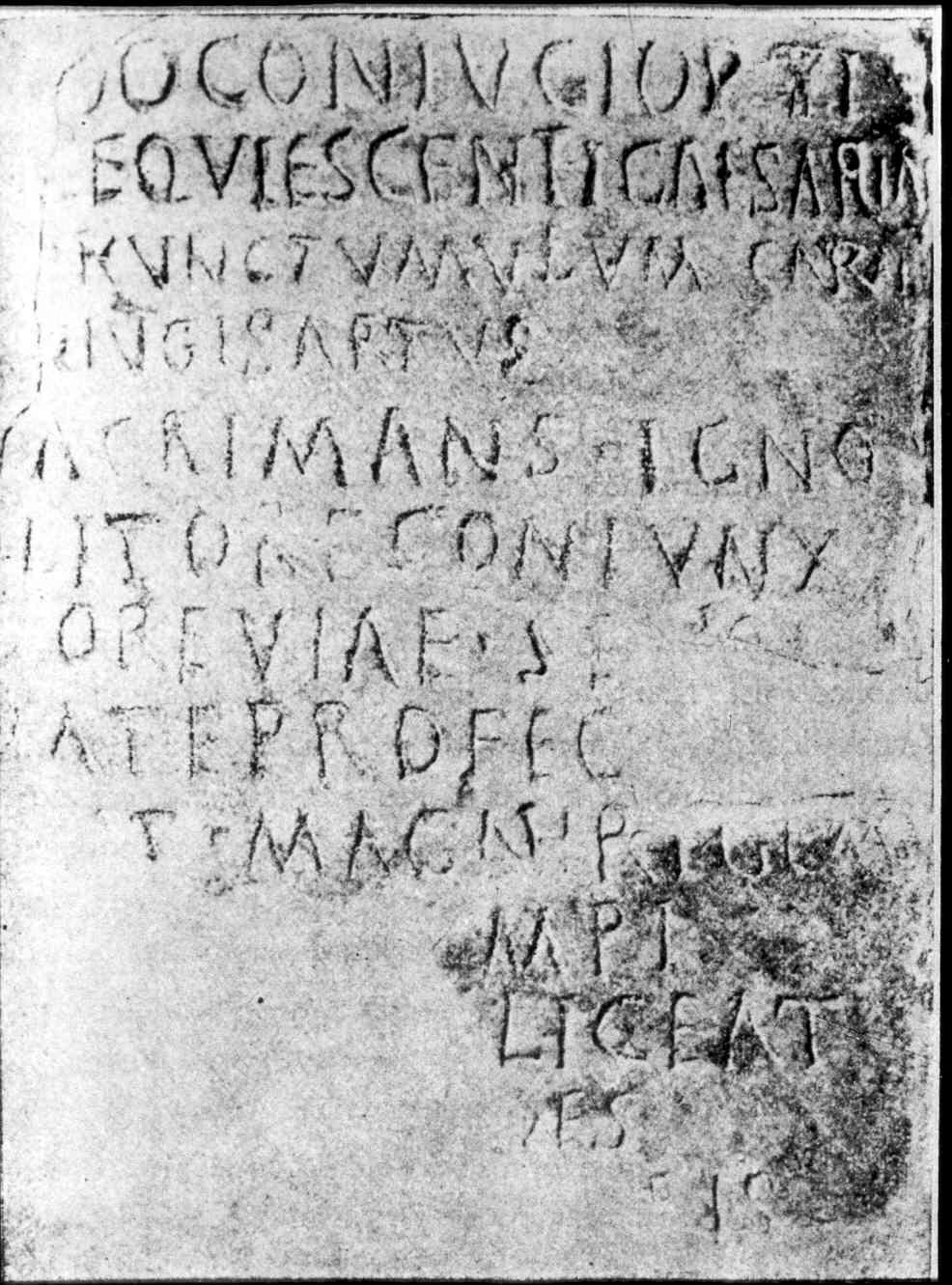(Español) GI1 Inscripción funeraria
Reference HEp 2002, 256 | Description | Lyrics | Location | Chronology | Epigraphic edition | Translation | Apparatus | Comentary | Type of verse | Text divided into verses and metric signs | Images | Bibliography | Link to DB | Author |
Description
- Idno filename 22/02/0038
- Type of inscription: Sepulcralis
- Support: Placa
- Material: Mármol
- Conservation status: Eran tres fragmentos sin molduras, que medía 38 x 25 PELLA. No tenemos otro tipo de medida de la inscripción (ni letras ni espacios ni profundidad).
- Perdida
Lyrics
- Font:Irregular
- Description of the letters:Por lo que se refiere a la paleografía, destacan las G, con el segundo trazo perpendicular a la caja y sin remate; y la P de l. 1, que tiene cierta tendencia libraria y un óculo muy grande en comparación con las otras P (ll. 8 y 10).
Location
- Place of discovery: Según NOLLA-CASAS 1984, la inscripción se habría encontrado cerca de la Iglesia de Llafranc, en una necrópolis de datación tardía (siglos IV-V dC). PELLA indica que la encontró en una casa de Palafrugell procedente de la playa de Llafranch ha muchos años.
- Geolocation
- Location with Modern Nomenclature España / Barcelona / Llafranc
- Location with Old Nomenclature Hispania / Citerior / Tarraconensis / Llafranch
Chronology
- Inscription's dating: Between year 301 and year 499
- Dating explanation: El contexto arqueológico en el que fue encontrada la inscripción y la paleografía de algunas de sus letras (sobre todo la P de l.1) hacen pensar en una datación entre los siglos IV y V d. C .
Type of verse
- Type of verse: Dactílico (hexámetro)
- Verse/line correspondence: No
- Prose/verse distinction: No
Epigraphic edition
[‑ ‑ ‑]ḍo coniugi opti
[‑ ‑ ‑]e quiescenti Caesaria[e?]
ḥunc tumulum cari
[‑ ‑ ‑]+iugis artus (vac.)
5 [l]acrimans igno[‑ ‑ ‑]
litore coniunx [ (vac.) ]
ore viae ▴ se[‑ ‑ ‑]+o[‑ ‑ ‑]
[‑ ‑ ‑]ate profec[‑ ‑ ‑] [ (vac.) ]
[‑ ‑ ‑]ịt ▴ magni regem
10 [‑ ‑ ‑]mpi (vac.)
[‑ ‑ ‑] liceat
[‑ ‑ ‑]+es (vac.)
[‑ ‑ ‑]+is
Text divided into verses and metric signs
[‑ ‑ ‑] hunc tumulum, cari[- – – co]niugis artus, [ln]|l/kk|l/l|l[n|l]kk|l~
[‑ ‑ ‑ l]acrimans igno[‑ ‑ ‑] litore coniunx, [ln|l]kk|l/l|l[n]|lkk|l~
[‑ ‑ ‑]ore viae se[- – -]o [- – -]ate profec[‑ ‑ ‑] [ln]|lkk|l/x|[ln|ln]|lkl|[l~]?
[‑ ‑ ‑]it magni regem [‑ ‑ ‑]mpi [ln]|l/l|l/l|x[n|lkk]|
5 [‑ ‑ ‑] liceat [‑ ‑ ‑]es. [ln|ln|l]/kk|l/[n|lkk|l]~
Translation
No procede hacer traducción alguna de los mínimos fragmentos.
Bibliography
Fotografía de Fabre – Mayer – Rodà, IRC III, 187 tab. LIV, tomada por E. Olivella. Pella 1883, 274 et 357–358 (inde Fita 1906, 56–58, im. phot. in p. 57; Vives, ICERV 300; Nolla – Casas 1984, 137; Fabre – Mayer – Rodà, IRC III, 187, cum tabula, tab. LIV; Gómez Pallarès, PEPC, GI1, qui in linguam Catalanam vertit [HEp 2002, 256]; Cugusi 2012, 136). – Cf. Smit 1916, 142; Gudiol 1925, 318–319; Aguirre 1957, 131–133; Gómez Pallarès 1995b, 73.
Apparatus
Sic suppl. hexametri Pella, non recte: [Caru]do coniugi opti[mo in pa[ce] quiescenti Caesaria/ [condit in] hunc tumulum Car[di co]niugis artus/ [Caesaria ill] acrimans ingno[to] litore coniunx / [quem maer]ore viae sen[io piet]ate profec[tum] / [excipiu]nt magni regem [super aethera ca]mpi / [ut paradisiacas] liceat [conscendere se]des / [obiit —Octob]ris; 1 [—] do Fabre – Mayer – Rodà. – 2 [—]ce quiescenti Fabre – Mayer – Rodà; Caesaria aut Caesaria[e?] Fabre – Mayer – Rodà. – 3 Carudi Vives, cari Fabre – Mayer – Rodà. – 4 [—]niugis artus Fabre – Mayer – Rodà. – 7 [hinc err]ore viae Vives; se[n]io Fabre – Mayer – Rodà. – 8 [—]tate Fabre – Mayer – Rodà. – 9 regem Fabre – Mayer – Rodà. – 11 liceat [mhi visere se]des Vives. –12 [—]des Fabre – Mayer – Rodà, Vives. – 13 [dux et lumen e]ris [fidae memor esto iugalis] Vives; [—]ris Fabre – Mayer – Rodà.
Comentary
En el aspecto métrico, Fabre – Mayer – Rodà, IRC III, 187 ya observan que se trata de hexámetros, probablemente todos ellos regulares, aunque no comenzarían en l. 1 como creían, sino en l. 3, llegando hasta l. 13. Cada verso del carmen se divide en dos líneas del texto, y hay un vacat al final de los versos (ver ll. 4, 10 y 12). En l. 3: cari] Vives, ICERV 300 propone Carudi, que, a partir tan sólo de la foto, parece no tener cabida en el texto.
Author
- Author:J. Gómez Pallarès
- Last Update2023-03-31 11:28:08
You can download this






